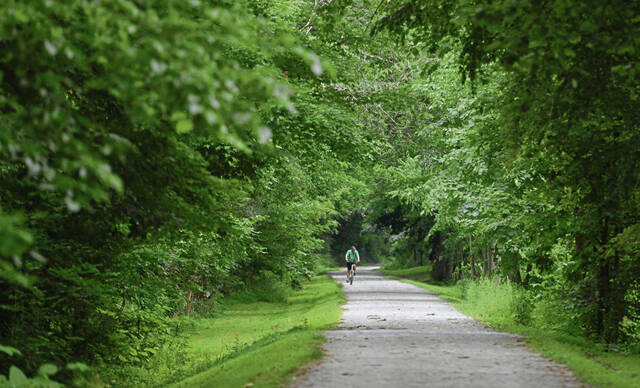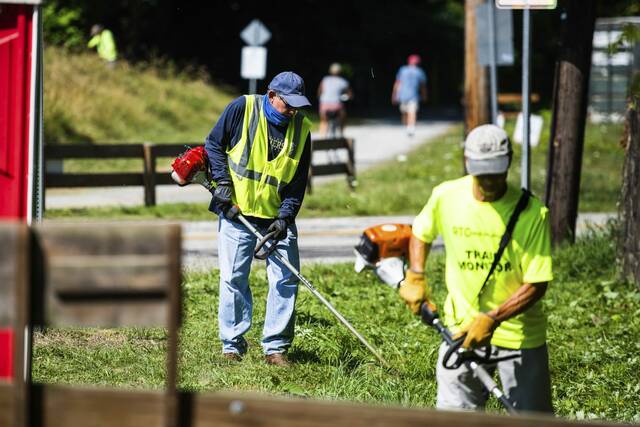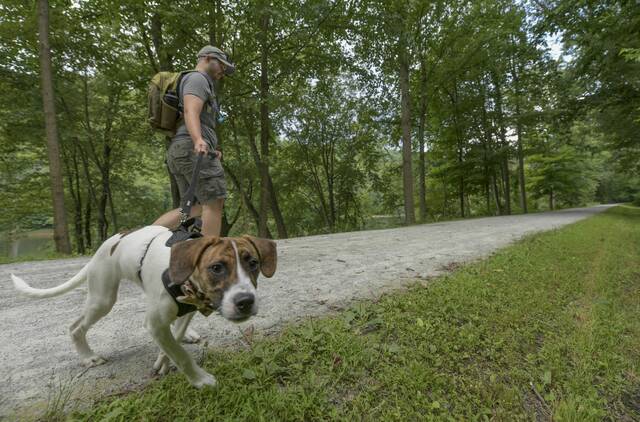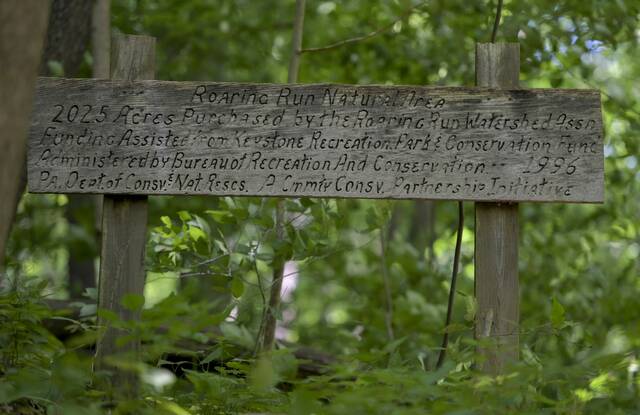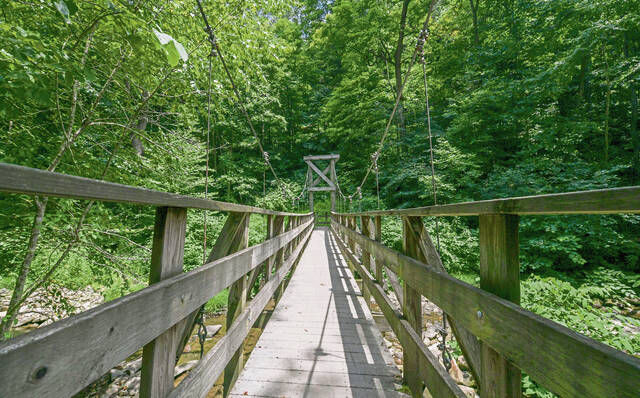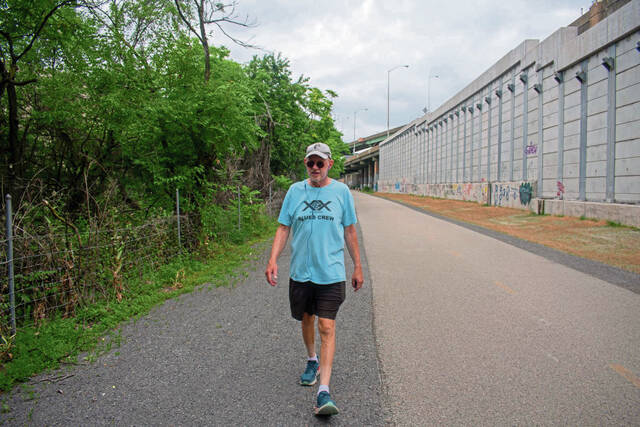Stepping up: Volunteers donate thousands of hours of time maintaining the region’s myriad hiking, biking trails
As walkers, hikers and bikers make their way onto the crushed limestone gravel of one of Western Pennsylvania’s many trail systems, it might not seem as though they are merging onto an economic highway.
But if they’re stepping onto the Great Allegheny Passage — the trail between Pittsburgh’s Point State Park and Cumberland, Md., — that “highway” generated more than $121 million in economic impacts in 2019, according to a report prepared by national community consulting firm Fourth Economy.
Throughout Western Pennsylvania, residents have access to more than 300 miles of trails in more than 25 locations. And many take advantage: Estimates show the trails get about 3 million visitors annually.
Many trails see heavy use and require regular maintenance, which is handled largely through a cooperative effort among trail officials, volunteer groups and the towns through which they pass.
Managing miles
In West Newton, Leslie Pierce serves as business manager for the nonprofit Regional Trail Corp., which acquires land, promotes trail development and helps maintain sections of the Great Allegheny Passage, Westmoreland Heritage, Coal & Coke and Five Star trails.
“We have a core of people that we rely on,” Pierce said. “But we’re not getting any younger.”
The RTC organizes trail maintenance through 10 local chapters or organized local trail councils.
Bryan Perry, executive director of the Great Allegheny Passage Conservancy, said volunteers are the main force behind trail maintenance of the GAP, handling everything apart from projects requiring contractors.
“We wouldn’t be anywhere without the good graces of the folks coming out on a Saturday morning or Wednesday with hedge trimmers and clippers,” he said.
The GAP trail is owned by seven primary entities, ranging from nonprofits to county offices, Perry said. Each of the owners maintains the section of the trail within their regional footprint. Although some of the entities have a few paid employees, few of them focus solely on managing the trail.
According to Perry, this is what makes the volunteers so essential. He estimates there are hundreds of volunteers who perform more than 10,000 hours of trail maintenance annually.
“It’s quite remarkable what these volunteers do,” Perry said.
Friends of the Riverfront, a nonprofit and primary overseer of the Three Rivers Heritage Trail that has portions in Downtown Pittsburgh, is one of the conservancy’s partners — about six miles of the Heritage are also part of the GAP.
Executive Director Kelsey Ripper said Friends of the Riverfront has about seven part-time or full-time employees, two of whom focus only on trail maintenance. But the 1,500 volunteers assisting with trail maintenance each year are what make much of the day-to-day tasks possible.
“Volunteers play a really critical role in making sure the trails are usable for everybody,” Ripper said.
In the Alle-Kiski Valley, the Roaring Run and Rock Furnace trails are managed by the Roaring Run Watershed Association, formed in 1983. Its 13-member volunteer board helps maintain more than 650 acres in southern Armstrong County, which includes the 6.5 miles of both trails.
Over the years, the trails have been expanded as the association secured grants and donations, according to association President Ken Kaminski, who said the whole Roaring Run trail works off volunteers, fundraisers and donations. The association gets no government money unless it receives a grant, and oftentimes the association must match the grant money awarded. It recently had to match an $80,000 grant it received for trail repair work.
“You could always use more volunteers,” Kaminski said.
Deb Thompson, president of the Montour Trail Council, said there is more to trail volunteer work than people realize.
When fallen trees and branches scatter across the 60-mile trail, volunteers can be found hitting the limestone the following day to keep the space usable.
“We have so much work to do, and we really rely on volunteers,” Thompson said.
The trail is divided into seven “friends groups,” each of which is responsible for maintaining one section of the trail.
Thompson said the groups are not only responsible for the physical trail maintenance labor but also patrolling the trail to make sure visitors are following trail rules, producing the trail newsletter that is released every two months and managing finances.
Despite having more than 8,000 registered council members, Thompson said she estimates 80 people volunteer regularly. Many registered members are inactive or exclusively donors.
Trail funding is an important issue for the council, Thompson said, but “keeping enough volunteers is the bigger problem.”
Financial burden
Perry estimated that the GAP spends about $5,000 per year on maintenance, which he says is a conservative estimate. Larger construction projects such as re-decking, repaving or bridge repairs may need done every decade or so, but the cost for one of those projects can easily reach $1 million.
Ripper said the financial situation is further complicated by the reality that there are more funding opportunities available to build new trails than to maintain what exists.
“There is just generally not enough money for maintaining trails,” she said.
Ripper said larger projects can be funded with grants from the Department of Conservation and Natural Resources, Allegheny Regional Asset District, Department of Community and Economic Development, and local municipalities’ city budgets. Daily maintenance, however, requires donations and volunteer labor.
For a flooding and drainage project near Hays Woods, Friends of the Riverfront has raised more than $200,000 in three years. Ripper said the nonprofit also receives $70,000 in individual donations and $65,000 in corporate donations annually, part of which is used for trail maintenance.
Considering the impact trails have on the towns they pass through, the lack of funding they have to work with may seem shocking.
According to the 2019 economics impact report, the estimated average annual wage of GAP-supported jobs is $38,000. This estimate equates to $52.6 million in labor income and 1,393 jobs generated.
The GAP recorded 1.4 million visits to the trail each year in 2020 and 2021, Perry said.
Yet, its most recent nonprofit income report detailed about $563,000 in expenses and $358,000 in revenue, leaving the conservancy with a nearly $205,000 deficit.
To top it off, Perry said maintenance dollars do not have the same impact they had before the pandemic.
“With the cost of limestone going up and the price of labor going up, maintenance is getting difficult, but we intend to keep the entire GAP open,” Perry said. “We’re all working hard to raise money for maintenance, knowing that maintenance dollars during the pandemic were harder to come by and don’t go as far now.”
A cooperative effort
Cooperation among trail management groups, volunteers and the towns where they are built can result in welcome additions.
In Murrysville, municipal officials partnered with the county and used state grant funding in 2017 to build the Roberts Trailhead, a small parking lot with easy access to the Westmoreland Heritage Trail, where the municipality’s recreation department has hosted nature programs and posted information for trail users.
But the day-to-day work of maintaining the trails is almost exclusively done by volunteers.
“In today’s world, looking at it honestly, younger couples with children get out and do enjoy the trail, but they don’t have the time to devote to helping maintain it,” Pierce said. “A lot of our people were already retired when they started helping. The hope is that people who use the trail will be interested in taking the same type of ownership, but will it be in time to take the place of our people who are ready to put up their shovels?”
MORE TRAIL NEWS
• Trail along Kiski and Allegheny rivers to receive $3.5 million boost
• Study identifies potential east suburb path to connect Westmoreland, Allegheny trails
• Hampton embarks on Phase 2 of community trail
Groups are also looking for ways to unify the region’s trail system through interconnections.
Kaminski said a group in the Avonmore area is exploring ways to connect the Roaring Run/Rock Furnace Trail to the West Penn Trail that runs north out of Saltsburg.
“It would be great if they could,” he said. “But the big hold-up is the railroad. (They) want to go along the tracks, but that’s a no-no (due to safety issues).”
In Delmont, a citizen group called the Delmont Visionary Committee would like to build a spur from the as-yet-unbuilt fifth phase of the Westmoreland Heritage Trail, which would lead directly into the heart of the borough.
But if those connections and spurs get built, they will need to be maintained, and that work will likely fall to volunteers.
“It’s not to say we don’t have younger volunteers — we do have a few,” Pierce said. “But people are just too busy in the world today. Even folks who are retired, a lot of them want to travel.”
Patrick Varine, Quincey Reese and Megan Swift are Tribune-Review staff writers.
Remove the ads from your TribLIVE reading experience but still support the journalists who create the content with TribLIVE Ad-Free.


